Analyzing the Freight Characteristics and Carbon Emission of Construction Waste Hauling Trucks: Big Data Analytics of Hong Kong
Abstract
:1. Introduction
2. Literature Review
2.1. Freight Performance Metrics
2.2. Freight Carbon Emission
2.3. Freight Data
3. Construction Waste Disposals in Hong Kong
4. Data and Method
4.1. Data Description
4.2. Research Design
4.2.1. Data Processing
4.2.2. Freight Performance Metrics Analyses
4.2.3. Freight Carbon Emission Measurement
5. Data Analyses, Results, and Findings
5.1. Freight Performance
5.1.1. Vehicle Type
5.1.2. Transporting Weight
5.1.3. Trip Length
5.1.4. Trip Duration
5.2. Carbon Emission Performance
5.3. Daily Freight Performance and Carbon Emission
6. Discussion
7. Conclusions and Implications
Author Contributions
Funding
Institutional Review Board Statement
Informed Consent Statement
Data Availability Statement
Conflicts of Interest
References
- Chen, J.; Su, Y.; Si, H.; Chen, J. Managerial Areas of Construction and Demolition Waste: A Scientometric Review. Int. J. Environ. Res. Public Health 2018, 15, 2350. [Google Scholar] [CrossRef] [Green Version]
- Lu, W.S.; Lee, W.M.W.; Bao, Z.K.; Chi, B.; Webster, C. Cross-jurisdictional construction waste material trading: Learning from the smart grid. J. Clean. Prod. 2020, 277, 123352. [Google Scholar] [CrossRef]
- Luo, J.; Chen, S.; Li, Q.; Liu, C.; Gao, S.; Zhang, J.; Guo, J. Influence of Graphene Oxide on the Mechanical Properties, Fracture Toughness, and Microhardness of Recycled Concrete. Nanomaterials 2019, 9, 325. [Google Scholar] [CrossRef] [PubMed] [Green Version]
- USEPA. Advancing Sustainable Materials Management: 2018 Fact Sheet. Available online: https://www.epa.gov/sites/default/files/2020-11/documents/2018_ff_fact_sheet.pdf (accessed on 30 April 2021).
- Defra UK Statistics on Waste. Available online: https://assets.publishing.service.gov.uk/government/uploads/system/uploads/attachment_data/file/1002246/UK_stats_on_waste_statistical_notice_July2021_accessible_FINAL.pdf (accessed on 30 April 2021).
- HKEPD Monitoring of Solid Waste in Hong Kong, Waste Statistics for 2019. Available online: https://www.wastereduction.gov.hk/sites/default/files/msw2019tc.pdf (accessed on 30 April 2021).
- Duan, H.; Li, J. Construction and demolition waste management: China’s lessons. Waste Manage. Res. 2016, 34, 397–398. [Google Scholar] [CrossRef] [PubMed] [Green Version]
- Lu, W.; Tam, V.W.Y. Construction waste management policies and their effectiveness in Hong Kong: A longitudinal review. Renew. Sustain. Energy Rev. 2013, 23, 214–223. [Google Scholar] [CrossRef] [Green Version]
- Kim, Y.; Zhang, Y.; Park, W.; Cha, G.; Kim, J.; Hong, W. Analysis of Waste Generation Characteristics during New Apartment Construction—Considering the Construction Phase. Int. J. Environ. Res. Public Health 2019, 16, 3485. [Google Scholar] [CrossRef] [PubMed] [Green Version]
- Akhtar, M.; Hannan, M.A.; Begum, R.A.; Basri, H.; Scavino, E. Backtracking search algorithm in CVRP models for efficient solid waste collection and route optimization. Waste Manag. 2017, 61, 117–128. [Google Scholar] [CrossRef] [PubMed]
- Sánchez-Díaz, I.; Holguín-Veras, J.; Ban, X.J. A time-dependent freight tour synthesis model. Transp. Res. Part B Methodol. 2015, 78, 144–168. [Google Scholar] [CrossRef] [Green Version]
- Cui, J.; Dodson, J.; Hall, P.V. Planning for Urban Freight Transport: An Overview. Transp. Rev. 2015, 35, 583–598. [Google Scholar] [CrossRef]
- Kuramochi, T.; Elzen, M.G.J.D.; Peters, G. Global Emissions Trends and G20 Status and Outlook. UN Emissions Gap Report 2019; United Nations Environment Programme: Geneva, Switzerland, 2020. [Google Scholar]
- Ritchie, H. Cars, Planes, Trains: Where Do CO2 Emissions from Transport Come from? Available online: https://ourworldindata.org/co2-emissions-from-transport (accessed on 12 January 2022).
- Wei, R.; Liu, C. Research on carbon emission reduction in road freight transportation sector based on regulation-compliant route optimization model and case study. Sustain. Comput. Inform. Syst. 2020, 28, 100408. [Google Scholar] [CrossRef]
- Milton, K.; Grix, J. Public health policy and walking in England-analysis of the 2008 ‘policy window’. BMC Public Health 2015, 15, 614. [Google Scholar] [CrossRef] [Green Version]
- Beliën, J.; Boeck, L.D.; Ackere, J.V. Municipal Solid Waste Collection and Management Problems: A Literature Review. Transp. Sci. 2014, 48, 78–102. [Google Scholar] [CrossRef]
- Combes, F.; Leurent, F. Improving road-side surveys for a better knowledge of road freight transport. Eur. Transp. Res. Rev. 2013, 5, 41–51. [Google Scholar] [CrossRef] [Green Version]
- Khan, M.; Machemehl, R. Commercial vehicles time of day choice behavior in urban areas. Transp. Res. Part A Policy Pract. 2017, 102, 68–83. [Google Scholar] [CrossRef]
- D’Este, G. Urban Freight Movement Modeling. In Handbook of Transport Modelling; David, A.H., Kenneth, J.B., Eds.; Emerald Group Publishing Limited: Bingley, UK, 2007; Volume 1, pp. 633–647. [Google Scholar]
- Errampalli, M.; Kayitha, R.; Chalumuri, R.S.; Tavasszy, L.A.; Borst, J.; Chandra, S. Assessment of urban freight travel characteristics—A case study of Delhi. Transp. Res. Procedia 2020, 48, 467–485. [Google Scholar] [CrossRef]
- Ruan, M.; Lin, J.J.; Kawamura, K. Modeling urban commercial vehicle daily tour chaining. Transp. Res. Part E Logist. Transp. Rev. 2012, 48, 1169–1184. [Google Scholar] [CrossRef]
- Lu, W. Big data analytics to identify illegal construction waste dumping: A Hong Kong study. Resour. Conserv. Recycl. 2019, 141, 264–272. [Google Scholar] [CrossRef]
- Nuzzolo, A.; Comi, A.; Polimeni, A. Urban Freight Vehicle Flows: An Analysis of Freight Delivery Patterns through Floating Car Data. Transp. Res. Procedia 2020, 47, 409–416. [Google Scholar] [CrossRef]
- Akter, T. Truck Activity Pattern Classification Using Anonymous Mobile Sensor Data. Ph.D. Thesis, University of Arkansas, Fayetteville, NC, USA, 2019. [Google Scholar]
- FHWA, F.H.A. Transportation Performance Measures. Available online: https://www.fhwa.dot.gov/tpm/rule/freightmeas20042016.pdf. (accessed on 30 April 2021).
- Schrank, D.; Eisele, B.; Lomax, T. TTI’s 2012 Urban Mobility Report; Texas Transportation Institute, Texas A&M University: College Station, TX, USA, 2012. [Google Scholar]
- Ehmke, J.F.; Steinert, A.; Mattfeld, D.C. Advanced routing for city logistics service providers based on time-dependent travel times. J. Comput. Sci. 2012, 3, 193–205. [Google Scholar] [CrossRef]
- Sulemana, A.; Emmanuel Amponsah, D.; Forkuo, E.K.; Sampson, O. Effect of optimal routing on travel distance, travel time and fuel consumption of waste collection trucks. Manag. Environ. Qual. 2019, 30, 803–832. [Google Scholar] [CrossRef]
- Comi, A.; Nuzzolo, A.; Polimeni, A. Aggregate delivery tour modeling through AVM data: Experimental evidence for light goods vehicles. Transp. Lett. 2021, 13, 201–208. [Google Scholar] [CrossRef]
- Cerminara, G.; Cossu, R. 1.2 - Waste Input to Landfills. In Solid Waste Landfilling; Cossu, R., Stegmann, R., Eds.; Elsevier: Amsterdam, The Netherlands, 2018; pp. 15–39. [Google Scholar]
- To, W.M. Greenhouse gases emissions from the logistics sector: The case of Hong Kong, China. J. Clean. Prod. 2015, 103, 658–664. [Google Scholar] [CrossRef]
- Lee, K. Integrating carbon footprint into supply chain management: The case of Hyundai Motor Company (HMC) in the automobile industry. J. Clean. Prod. 2011, 19, 1216–1223. [Google Scholar] [CrossRef]
- Tian, Y.; Zhu, Q.; Lai, K.; Venus Lun, Y.H. Analysis of greenhouse gas emissions of freight transport sector in China. J. Transp. Geogr. 2014, 40, 43–52. [Google Scholar] [CrossRef]
- Rodrigues Teixeira, A.C.; Machado, P.G.; Borges, R.R.; Felipe Brito, T.L.; dos Santos, E.M.; Mouette, D. The use of liquefied natural gas as an alternative fuel in freight transport—Evidence from a driver’s point of view. Energy Policy 2021, 149, 112106. [Google Scholar] [CrossRef]
- Talebian, H.; Herrera, O.E.; Tran, M.; Mérida, W. Electrification of road freight transport: Policy implications in British Columbia. Energy Policy 2018, 115, 109–118. [Google Scholar] [CrossRef]
- Kellner, F. Allocating greenhouse gas emissions to shipments in road freight transportation: Suggestions for a global carbon accounting standard. Energy Policy 2016, 98, 565–575. [Google Scholar] [CrossRef]
- Sim, J. The influence of new carbon emission abatement goals on the truck-freight transportation sector in South Korea. J. Clean. Prod. 2017, 164, 153–162. [Google Scholar] [CrossRef]
- Van Vuuren, D.P.; Hoogwijk, M.; Barker, T.; Riahi, K.; Boeters, S.; Chateau, J.; Scrieciu, S.; van Vliet, J.; Masui, T.; Blok, K. Comparison of top-down and bottom-up estimates of sectoral and regional greenhouse gas emission reduction potentials. Energy Policy 2009, 37, 5125–5139. [Google Scholar] [CrossRef]
- Omara, M.; Sullivan, M.R.; Li, X.; Subramanian, R.; Robinson, A.L.; Presto, A.A. Methane Emissions from Conventional and Unconventional Natural Gas Production Sites in the Marcellus Shale Basin. Environ. Sci. Technol. 2016, 50, 2099–2107. [Google Scholar] [CrossRef]
- Ma, F.; Wang, Y.; Yuen, K.F.; Wang, W.; Li, X.; Liang, Y. The Evolution of the Spatial Association Effect of Carbon Emissions in Transportation: A Social Network Perspective. Int. J. Environ. Res. Public Health 2019, 16, 2154. [Google Scholar] [CrossRef] [PubMed] [Green Version]
- Gilman, J.B.; Lerner, B.M.; Kuster, W.C.; de Gouw, J.A. Source signature of volatile organic compounds from oil and natural gas operations in northeastern Colorado. Environ. Sci. Technol. 2013, 47, 1297–1305. [Google Scholar] [CrossRef] [PubMed]
- Hao, H.; Geng, Y.; Li, W.; Guo, B. Energy consumption and GHG emissions from China’s freight transport sector: Scenarios through 2050. Energy Policy 2015, 85, 94–101. [Google Scholar] [CrossRef]
- Sun, D.J.; Zhang, Y.; Xue, R.; Zhang, Y. Modeling carbon emissions from urban traffic system using mobile monitoring. Sci. Total Environ. 2017, 599–600, 944–951. [Google Scholar] [CrossRef] [PubMed]
- Lv, Q.; Liu, H.; Yang, D.; Liu, H. Effects of urbanization on freight transport carbon emissions in China: Common characteristics and regional disparity. J. Clean. Prod. 2019, 211, 481–489. [Google Scholar] [CrossRef]
- Alho, A.R.; You, L.; Lu, F.; Cheah, L.; Zhao, F.; Ben-Akiva, M. Next-generation freight vehicle surveys: Supplementing truck GPS tracking with a driver activity survey. In Proceedings of the 2018 21st International Conference on Intelligent Transportation Systems (ITSC), Maui, HI, USA, 4–7 November 2018; pp. 2974–2979. [Google Scholar]
- Rashidi, T.H.; Roorda, M.J. A business establishment fleet ownership and composition model. Transportation 2018, 45, 971–987. [Google Scholar] [CrossRef]
- Figenbaum, E. Can battery electric light commercial vehicles work for craftsmen and service enterprises? Energy Policy 2018, 120, 58–72. [Google Scholar] [CrossRef]
- Venkadavarahan, M.; Raj, C.T.; Marisamynathan, S. Development of freight travel demand model with characteristics of vehicle tour activities. Transp. Res. Interdiscip. Perspect. 2020, 8, 100241. [Google Scholar] [CrossRef]
- Sepasgozar, S.M.E.; Li, H.; Shirowzhan, S.; Tam, V.W.Y. Methods for monitoring construction off-road vehicle emissions: A critical review for identifying deficiencies and directions. Environ. Sci. Pollut. R 2019, 26, 15779–15794. [Google Scholar] [CrossRef]
- Siripirote, T.; Sumalee, A.; Ho, H.W. Statistical estimation of freight activity analytics from Global Positioning System data of trucks. Transp. Res. Part E Logist. Transp. Rev. 2020, 140, 101986. [Google Scholar] [CrossRef]
- Yang, W.H.; Wong, R.C.P.; Szeto, W.Y. Modeling the acceptance of taxi owners and drivers to operate premium electric taxis: Policy insights into improving taxi service quality and reducing air pollution. Transp. Res. Part A Policy Pract. 2018, 118, 581–593. [Google Scholar] [CrossRef]
- Ambrosini, C.; Routhier, J.L. Objectives, Methods and Results of Surveys Carried out in the Field of Urban Freight Transport: An International Comparison. Transp. Rev. 2004, 24, 57–77. [Google Scholar] [CrossRef]
- Yuan, H.; Lu, W.; Jianli Hao, J. The evolution of construction waste sorting on-site. Renew. Sustain. Energy Rev. 2013, 20, 483–490. [Google Scholar] [CrossRef] [Green Version]
- Lu, W.; Yuan, H. Off-site sorting of construction waste: What can we learn from Hong Kong? Resour. Conserv. Recycl. 2012, 69, 100–108. [Google Scholar] [CrossRef] [Green Version]
- Kang, P.; Song, G.; Xu, M.; Miller, T.R.; Wang, H.; Zhang, H.; Liu, G.; Zhou, Y.; Ren, J.; Zhong, R.; et al. Low-carbon pathways for the booming express delivery sector in China. Nat. Commun. 2021, 12, 450. [Google Scholar] [CrossRef] [PubMed]
- Bi, W.; Lu, W.; Zhao, Z.; Webster, C.J. Combinatorial optimization of construction waste collection and transportation: A case study of Hong Kong. Resour. Conserv. Recycl. 2021, 179, 106043. [Google Scholar] [CrossRef]
- HKEPD Construction Waste Disposal Charging Scheme. Available online: https://www.epd.gov.hk/epd/misc/cdm/scheme.htm (accessed on 20 April 2021).
- Hong Kong Green Organisation Certification Guidebook for Carbon Reduction Certificate. 2021. Available online: https://www.hkgoc.gov.hk/en-hk/carbon-reduction-certificate.html (accessed on 27 August 2021).
- Change, I. 2006 IPCC Guidelines for National Greenhouse Gas Inventories; Institute for Global Environmental Strategies: Kanagawa, Japan, 2006. [Google Scholar]
- Poon, C.S.; Yu, A.T.; Wong, A.; Yip, R. Quantifying the impact of construction waste charging scheme on construction waste management in Hong Kong. J. Constr. Eng. Manag. 2013, 139, 466–479. [Google Scholar] [CrossRef]
- Khan, M.; Machemehl, R. Analyzing tour chaining patterns of urban commercial vehicles. Transp. Res. Part A Policy Pract. 2017, 102, 84–97. [Google Scholar] [CrossRef]
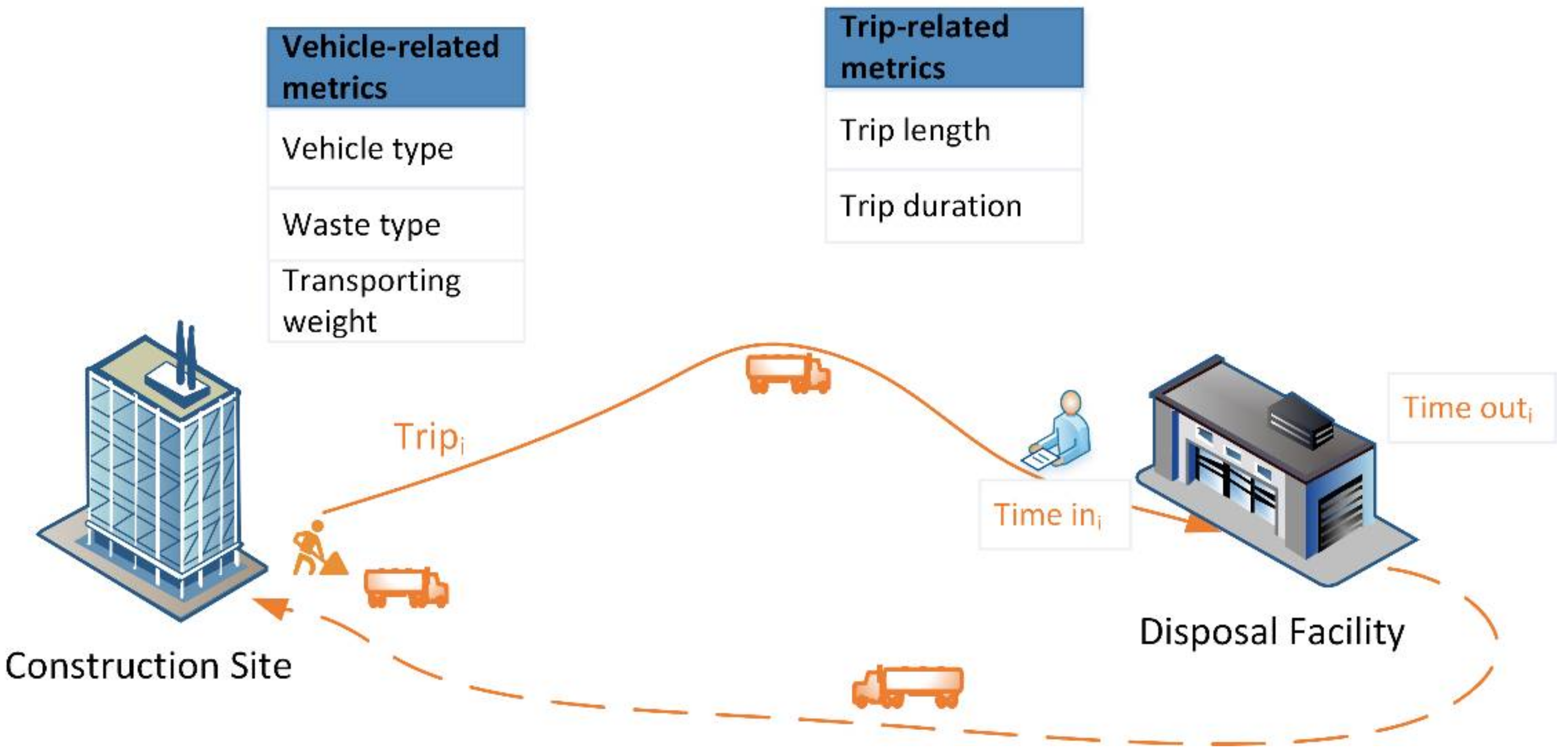

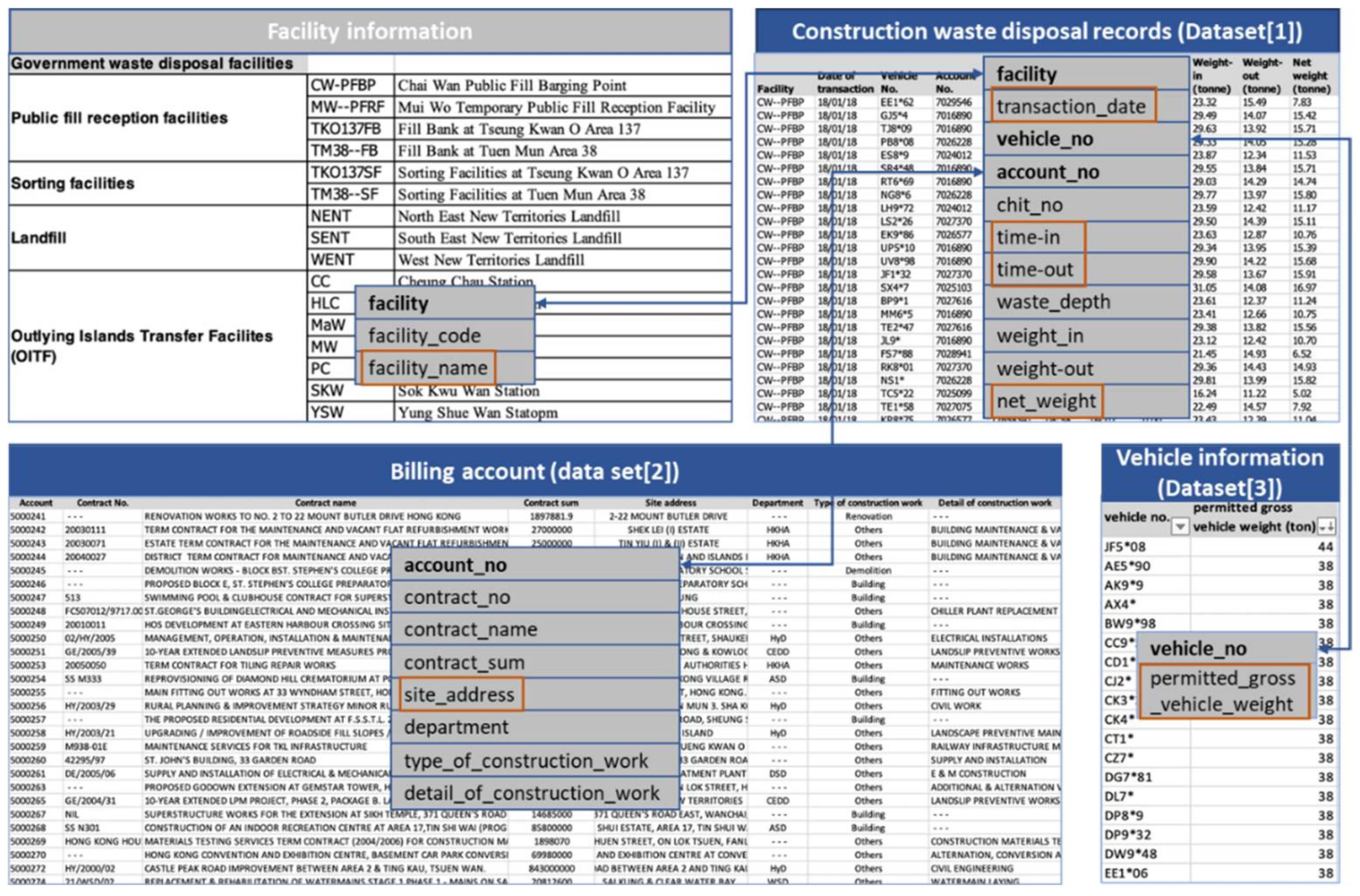

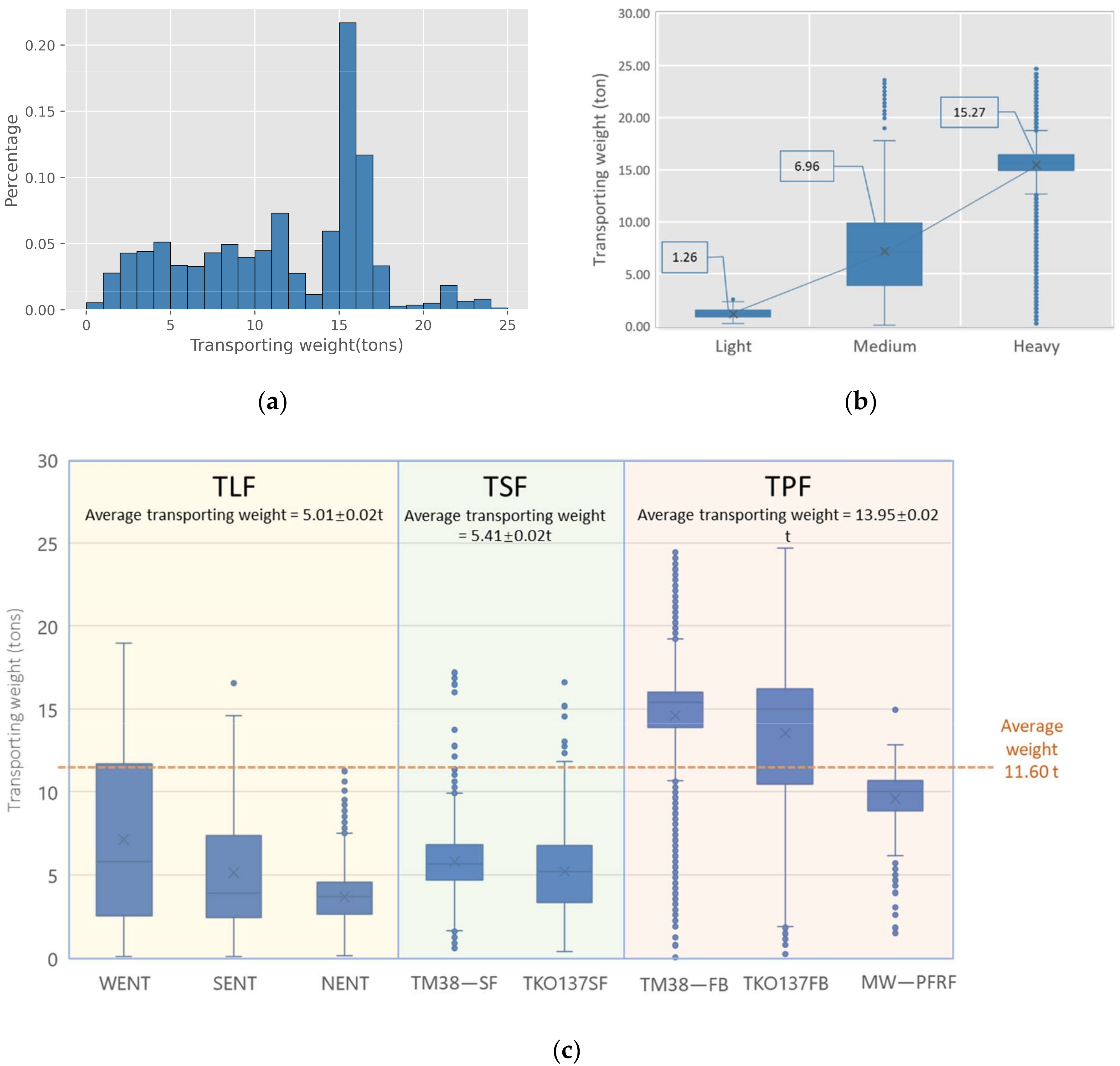

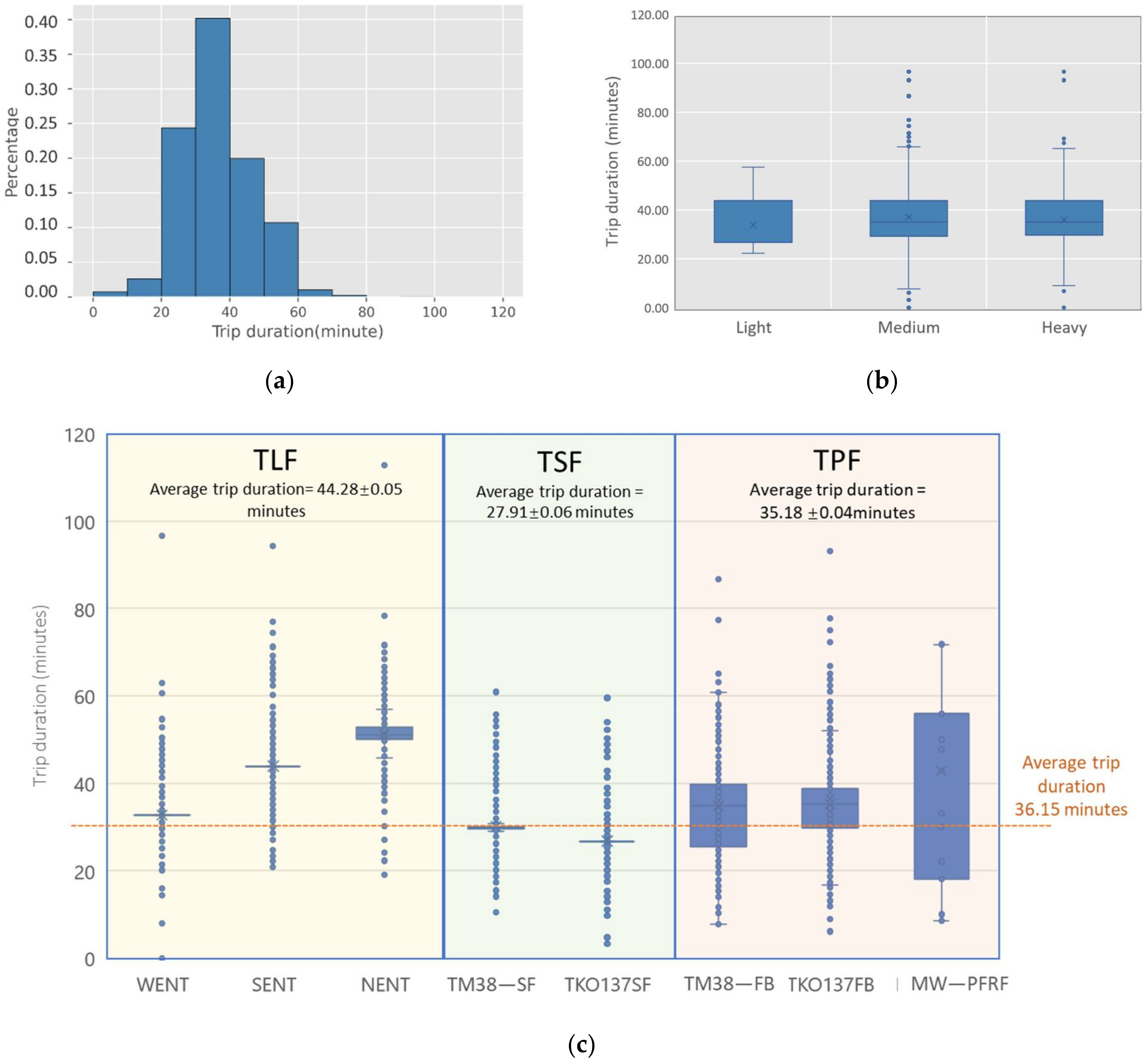

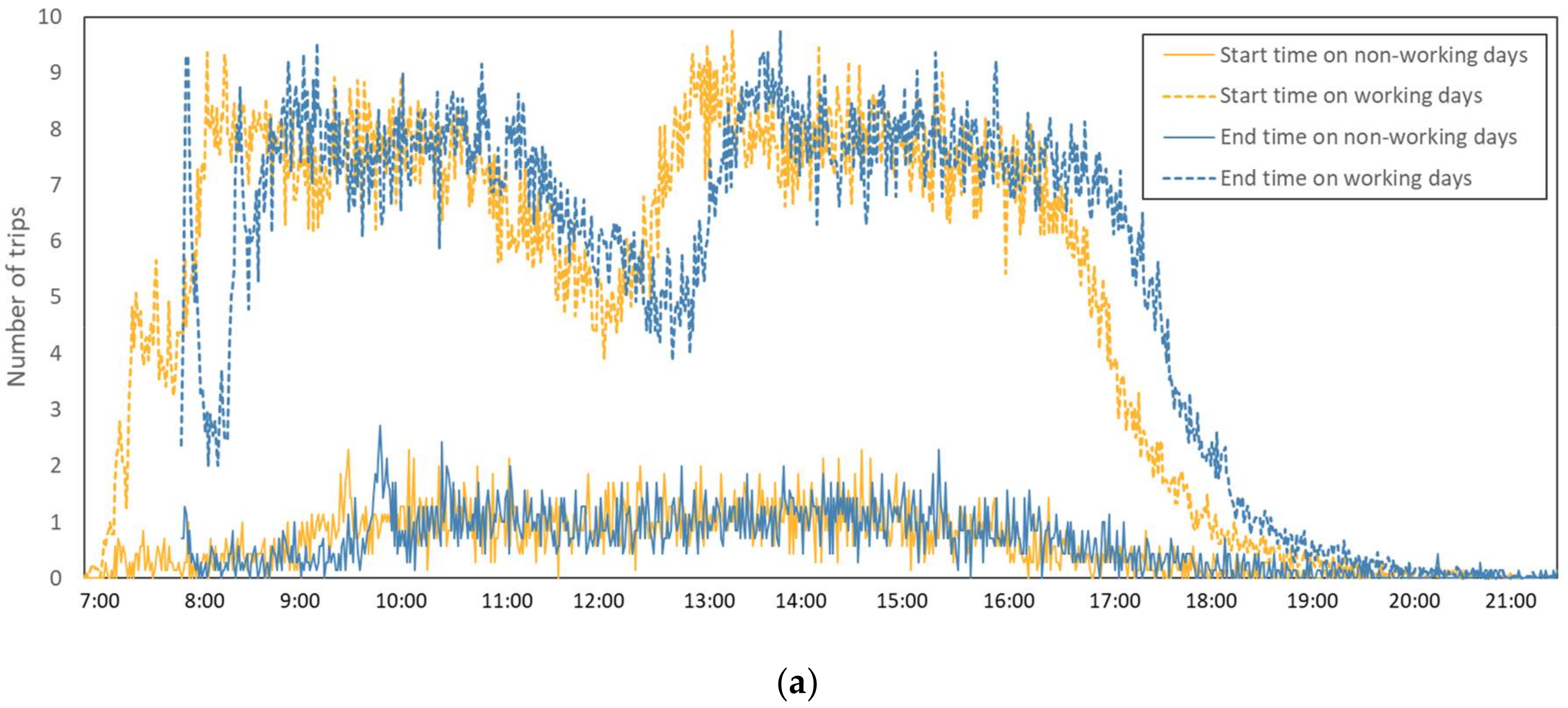

| Categories | Performance Metrics | Description | References |
|---|---|---|---|
| Vehicle-related | Vehicle type | Vehicles are normally classified into different types based on their load capacity as follows: light vehicles, medium vehicles, and heavy vehicles. | Combes and Leurent, 2013 [18], D’Este, 2007 [20], Khan and Machemehl, 2017 [19] |
| Commodity type | The key commodities include building and construction materials, consumer goods, industrial inputs, and waste. | Beliën et al., 2014 [17], Combes and Leurent, 2013 [18], Errampalli et al., 2020 [21], Ruan et al., 2012 [22] | |
| Weight capacity | The weight of commodity carried for a trip. | Combes and Leurent, 2013 [18], D’Este, 2007 [20], Errampalli et al., 2020 [21] | |
| Permitted gross vehicle weight | The maximum permitted loading weight. | D’Este, 2007 [20], Lu, 2019 [23] | |
| Ownership of the vehicles | Ownership of the vehicles can be divided into private companies, government, and individuals. | Errampalli et al., 2020 [21] | |
| Trip-related | Trip origin | Location of the trip origin. | Combes and Leurent, 2013 [18], Nuzzolo et al., 2020 [24] |
| Trip destination | Location of the trip destination. | Akter, 2019 [25], Combes and Leurent, 2013 [18] | |
| Departure time | The time starting from the origin. | Akter, 2019 [25], Nuzzolo et al., 2020 [24], Ruan et al., 2012 [22] | |
| Arrival time | The time reaching the destination. | Akter, 2019 [25], Ruan et al., 2012 [22] | |
| Trip length | Distance traveled by the truck from the origin of the trip to the destination. | Combes and Leurent, 2013 [18], Khan and Machemehl, 2017 [19], Nuzzolo et al., 2020 [24] | |
| Trip time | Time taken to travel from the origin of the trip to the destination. | Akter, 2019 [25], FHWA, 2017 [26], Khan and Machemehl, 2017 [19], Nuzzolo et al., 2020 [24], Schrank et al., 2012 [27] | |
| Trip speed | The average speed of the trip between the origin and the destination. | FHWA, 2017 [26], Khan and Machemehl, 2017 [19] | |
| Number of stops | The number of stops for a trip. | Akter, 2019 [25], D’Este, 2007 [20], Nuzzolo et al., 2020 [24], Ruan et al., 2012 [22] | |
| Routing type | Variable, regular, fixed. | D’Este, 2007 [20] |
| Facility Type | Existing Facilities | Abbreviation | Type of Accepted Construction Waste |
|---|---|---|---|
| Public fills | Chai Wan Public Fill Barging Point | CW-PFBP | Entirely inert construction waste |
| Mui Wo Temporary Public Fill Reception Facility | MW–PFRF | ||
| Fill Bank at Tseung Kwan O Area 137 | TKO137FB | ||
| Fill Bank at Tuen Mun Area 38 | TM38–FB | ||
| Sorting facilities | Sorting Facilities at Tseung Kwan O Area 137 | TKO137SF | More than 50%, by weight, of inert construction waste |
| Sorting Facilities at Tuen Mun Area 38 | TM38–SF | ||
| Landfill facilities | Northeast New Territories Landfill | NENT | Not more than 50%, by weight, of inert construction waste |
| Southeast New Territories Landfill | SENT | ||
| West New Territories Landfill | WENT |
| Record | Description |
|---|---|
| Facility | The government waste disposal facilities for construction waste, as well as the destination of the construction waste hauling trucks for a trip. |
| Vehicle no | The license plate number of the trucks involved in transportation. |
| Transaction date | The date when the freight occurs. |
| Time-in | The time when the vehicle enters the facility, as well as the arrival time for a trip. |
| Time-out | The time when the vehicle exits the facility. |
| Net weight | The total weight of construction waste carried by hauling truck per trip. |
| Gross Vehicle Weight (GVW) | Average Energy Consumption (L/100 km) |
|---|---|
| GVW ≤ 2.5 tons | 10.2 |
| 2.5 tons < GVW ≤ 4 tons | 12.2 |
| 4 tons < GVW ≤ 5.5 tons | 18.6 |
| 5.5 tons < GVW ≤ 10 tons | 31.9 |
| 10 tons < GVW ≤ 15 tons | 34.3 |
| 15 tons < GVW ≤ 20 tons | 44.3 |
| 20 tons < GVW ≤ 24 tons | 54.1 |
| 24 tons < GVW ≤ 38 tons | 61.1 |
| Vehicle Type | CO2 | CH4 | NO2 | Transferring Factor | |||
|---|---|---|---|---|---|---|---|
| Emission Factor (kg/L) | GWP | Emission Factor (kg/L) | GWP | Emission Factor (kg/L) | GWP | ||
| Light CWHTs | 2.614 | 1 | 0.072 × 10−3 | 21 | 0.506 × 10−3 | 310 | 2.78 |
| Medium CWTHs | 0.145 × 10−3 | 0.072 × 10−3 | 2.84 | ||||
| Heavy CWHTs | 0.145 × 10−4 | 0.072 × 10−4 | 2.84 | ||||
| Freight Trip Type | Facility | Light Truck (0 < PGVW ≤ 5.5) | Medium Truck (5.5 < PGVW ≤ 24) | Heavy Truck (24 < PGVW ≤ 38) | Total Trips |
|---|---|---|---|---|---|
| TLF | NENT | 14 (0.28%) | 4468 (87.97%) | 597 (11.75%) | 5079 |
| SENT | 76 (0.61%) | 9061 (72.87%) | 3297 (26.52%) | 12,434 | |
| WENT | 5 (0.20%) | 1174 (45.84%) | 1382 (53.96%) | 2561 | |
| TSF | TKO137SF | 217 (3.28%) | 6023 (90.97%) | 381 (5.75%) | 6621 |
| TM38–SF | 24 (0.70%) | 2890 (83.72%) | 538 (15.59%) | 3452 | |
| TPF | MW–PFRF | 5 (0.42%) | 1198 (99.58%) | 1203 | |
| TKO137FB | 14 (0.03%) | 16,427 (37.29%) | 27,612 (62.68%) | 44,053 | |
| TM38–FB | 1 (0.02%) | 8042 (31.00%) | 29,496 (68.98%) | 37,539 | |
| Total trips | 356 (0.32%) | 49,283 (43.64%) | 63,303 (56.05%) | 112,942 | |
| Trip Type | TLF | TSF | TPF | |
|---|---|---|---|---|
| Total transporting weight (ton) | a | 100,694 | 54,504 | 1153,40 |
| Total carbon emission (kg) | b | 1,264,269 | 467,825 | 5,852,637 |
| Carbon emission efficiency of construction waste transportation (kg CO2-eq/ton waste) | b/a | 12.56 | 8.58 | 5.07 |
| Travel Types | TLF | TSF | TPF | Daily | |
|---|---|---|---|---|---|
| Working days | Number of trips | 763 (17%) | 392 (9%) | 3390 (74%) | 4544 |
| Transporting weight (ton) | 3704.06 (7%) | 2135.67 (4%) | 47,270.79 (89%) | 53,110.52 | |
| Trip length (km) | 19,488.03 (17%) | 7711.85 (6%) | 89,510.99 (77%) | 116,711.86 | |
| Trip duration (h) | 565.89 (20%) | 182.40 (7%) | 1997.82 (73%) | 2746.11 | |
| Carbon emission (ton CO2-eq) | 48.45 (16%) | 18.31 (6%) | 240.87 (78%) | 307.64 | |
| Trip duration/Trip length (h/100 km) | 2.90 | 2.37 | 2.23 | 2.35 | |
| Non-working days | Number of trips | 252 (46%) | 96 (17%) | 205 (37%) | 553 |
| Transporting weight (ton) | 1685.34 (33%) | 464.12 (9%) | 2977.28 (58%) | 5126.75 | |
| Trip length (km) | 5688.42 (50%) | 1861.84 (16%) | 3791.98 (34%) | 11,342.24 | |
| Trip duration (h) | 176.35 (58%) | 43.93 (14%) | 85.91 (28%) | 306.18 | |
| Carbon emission (ton CO2-eq) | 14.49 (50%) | 4.05 (14%) | 10.24 (36%) | 28.78 | |
| Trip duration/Trip length (h/100 km) | 3.10 | 2.36 | 2.27 | 2.69 |
Publisher’s Note: MDPI stays neutral with regard to jurisdictional claims in published maps and institutional affiliations. |
© 2022 by the authors. Licensee MDPI, Basel, Switzerland. This article is an open access article distributed under the terms and conditions of the Creative Commons Attribution (CC BY) license (https://creativecommons.org/licenses/by/4.0/).
Share and Cite
Wei, X.; Ye, M.; Yuan, L.; Bi, W.; Lu, W. Analyzing the Freight Characteristics and Carbon Emission of Construction Waste Hauling Trucks: Big Data Analytics of Hong Kong. Int. J. Environ. Res. Public Health 2022, 19, 2318. https://doi.org/10.3390/ijerph19042318
Wei X, Ye M, Yuan L, Bi W, Lu W. Analyzing the Freight Characteristics and Carbon Emission of Construction Waste Hauling Trucks: Big Data Analytics of Hong Kong. International Journal of Environmental Research and Public Health. 2022; 19(4):2318. https://doi.org/10.3390/ijerph19042318
Chicago/Turabian StyleWei, Xiaoxuan, Meng Ye, Liang Yuan, Wei Bi, and Weisheng Lu. 2022. "Analyzing the Freight Characteristics and Carbon Emission of Construction Waste Hauling Trucks: Big Data Analytics of Hong Kong" International Journal of Environmental Research and Public Health 19, no. 4: 2318. https://doi.org/10.3390/ijerph19042318
APA StyleWei, X., Ye, M., Yuan, L., Bi, W., & Lu, W. (2022). Analyzing the Freight Characteristics and Carbon Emission of Construction Waste Hauling Trucks: Big Data Analytics of Hong Kong. International Journal of Environmental Research and Public Health, 19(4), 2318. https://doi.org/10.3390/ijerph19042318





